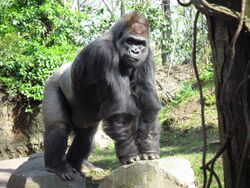Biology:Pongidae
| Pongidae Temporal range: Late Miocene to Recent
| |
|---|---|

| |
| Gorilla in the Bronx Zoo | |
| Scientific classification (obsolete) | |
| Domain: | Eukaryota |
| Kingdom: | Animalia |
| Phylum: | Chordata |
| Class: | Mammalia |
| Order: | Primates |
| Suborder: | Haplorhini |
| Infraorder: | Simiiformes |
| Superfamily: | Hominoidea |
| Family: | Pongidae Elliot, 1913 |
| Genera | |
Pongidae /ˈpɒndʒɪdiː/, or the pongids is an obsolete primate taxon containing chimpanzees, gorillas and orangutans. By this definition pongids were also called "great apes". This taxon is not used today but is of historical significance. The great apes are currently classified as Hominidae. This entry addresses the old usage of pongid.
The words "Pongidae" and "pongids" are sometimes used informally for the primate taxon containing orangutans and their extinct fossil relations. For this usage the currently most widely accepted name is Ponginae (or informally Asian hominids or pongines), the orangutan subfamily of the Hominidae or hominids. In current hominid taxonomy there is no “pongid” taxon. The orangutan taxon is now known to be paraphyletic to other (African) hominids. The orangutans are the only surviving species of the subfamily Ponginae, which genetically diverged from the other hominids (gorillas, chimpanzees and humans) between 19.3 and 15.7 million years ago. The subfamilies split somewhat later. The corresponding crown group for this taxon is Hominidae.
Distinction of great apes (formerly pongids) to hominins
| Great apes (formerly pongids) | Humans[notes 1] | |
|---|---|---|
| Mode of locomotion | Knuckle walking, arboreal | Bipedalism |
| Location of foramen magnum | Back of the skull | Under the skull |
| Skull (viewed from top) | pear-shaped | ovoid |
| Widest part of skull viewed from behind | Parietal region | Base of the skull(near the auditory region) |
| Palate | Rectangular | Parabolic |
| Body growth | Fast | Slow |
| Phalanges | Curved | Straight |
Skull
The great ape (formerly pongid) skull contains the following features that are absent or less pronounced in humans:
- a sulcus behind the brow ridges
- prognathism
- a protruding occipital region
- large, bony eye sockets
- a large nasal opening
- constriction just behind the orbital region
- stout facial bones
- a diastema
- a simian shelf
- a more larger, well pronounced brow ridge
Adaptations for locomotion
The following great ape (formerly Pongid) adaptations are for arboreal and knuckle walking locomotion and are not found in humans:
| Great ape (formerly pongid} | Human |
|---|---|
| Arms are longer than the legs | Arms are shorter than the legs |
| Scapula has an orientation for supporting the body weight beneath the arms | Scapula is oriented for holding the arms by the side |
| Digits are long and curved for grasping branches | Digits are shorter and straight |
| Pelvis is shaped to support the legs and trunk in the bent-over posture | Pelvis is shaped to support the legs and trunk in a vertical position |
| Knees do not lock the legs | Knees lock the legs straight to minimize the expenditure of energy when standing |
| Pelvis is relatively large | Pelvis is much shorter and bowl-shaped |
| Iliac pillar is elongated | The iliac crest is oriented more to the side and slanted |
Similarity to hominins
The australopithecines show intermediate character states between great apes (formerly pongids) and humans, with Homo erectus (formerly Pithecanthropus) intermediate between australopithecines and humans. Members of the genus Homo share many key features with anatomically modern man.
See also
- Anoiapithecus
- Chororapithecus
- History of hominoid taxonomy
- Pierolapithecus
- Samburupithecus
References
- ↑ Humans are the only extant Homininans.
External links
Wikidata ☰ Q3396223 entry
 |

